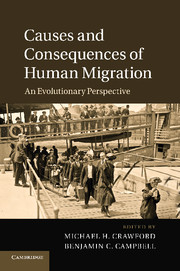Book contents
- Frontmatter
- Contents
- Contributors
- Preface
- 1 Perspectives on human migration: introduction
- Section 1 Theory
- 2 Genetic evidence concerning the origins and dispersals of modern humans
- 3 The biology of human migration: the ape that won’t commit?
- 4 Evolutionary basis of human migration
- 5 Evolutionary consequences of human migration: genetic, historic, and archaeological perspectives in the Caribbean and Aleutian Islands
- 6 Kin-structured migration and colonization
- 7 The role of diet and epigenetics in migration: molecular mechanisms underlying the consequences of change
- Section 2 Geography and migration
- Section 3 Overview
- Index
- References
6 - Kin-structured migration and colonization
Published online by Cambridge University Press: 05 December 2012
- Frontmatter
- Contents
- Contributors
- Preface
- 1 Perspectives on human migration: introduction
- Section 1 Theory
- 2 Genetic evidence concerning the origins and dispersals of modern humans
- 3 The biology of human migration: the ape that won’t commit?
- 4 Evolutionary basis of human migration
- 5 Evolutionary consequences of human migration: genetic, historic, and archaeological perspectives in the Caribbean and Aleutian Islands
- 6 Kin-structured migration and colonization
- 7 The role of diet and epigenetics in migration: molecular mechanisms underlying the consequences of change
- Section 2 Geography and migration
- Section 3 Overview
- Index
- References
Summary
Introduction
The process of Mendelian heredity whereby genes are passed from parents to offspring creates biological kinship; kin in this sense are individuals sharing alleles identical by descent from a common ancestor. This mechanism is the basis of inclusive fitness (Hamilton, 1964) and kin selection (Maynard Smith, 1964). Cooperation, even altruism, becomes rational from this shared gene perspective. In contrast, mating with close kin, inbreeding, may have negative fitness consequences. Thus genetic kinship motivates social behavior promoting association and cooperation among kin and regulating mating to avoid inbreeding.
Dispersal, the non-return migration of individuals, has associated costs and benefits (see Shields, 1987). Among other costs, dispersers lose the support of their biological kin in the natal population. On the positive side, finding unrelated mates in the new population avoids inbreeding depression.
Humans, as social animals, share this basic pattern of kin cooperation and the avoidance of inbreeding. However, in addition, human societies are characterized by elaborate systems of kin reckoning and relationships. These systems of consanguinity and affinity have formed the basis for social relations throughout most of our history. The diversity of forms of kinship has been a major focus of research by anthropologists over the history of the discipline.
- Type
- Chapter
- Information
- Causes and Consequences of Human MigrationAn Evolutionary Perspective, pp. 87 - 100Publisher: Cambridge University PressPrint publication year: 2012
References
- 3
- Cited by



